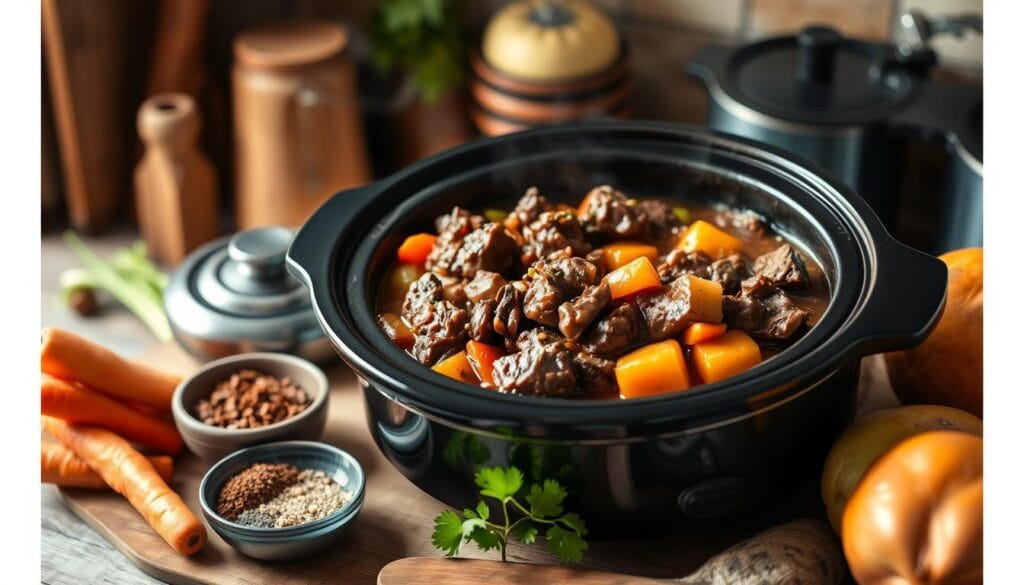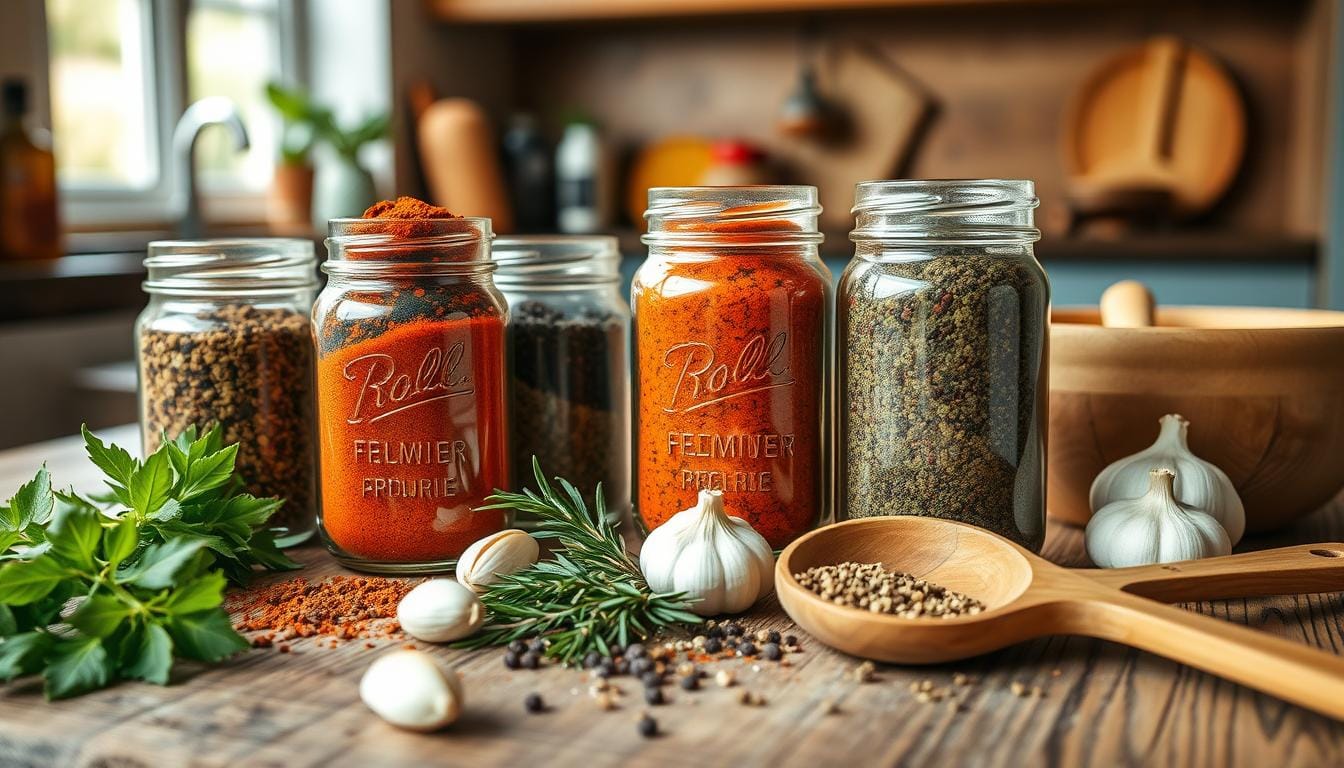As autumn arrives, nothing beats the smell of a warm beef stew. The secret to a great stew is the seasoning blend you pick. After trying many mixes, I made my own seasoning. It’s a real game-changer.
This mix of pantry spices and herbs gives your stew amazing flavor. It lets you control the salt and ingredients for a fresh taste. Just a few tablespoons per pound of meat makes your stew incredibly rich and satisfying. Your family and friends will keep coming back for more.
Key Takeaways
- Homemade beef stew seasoning offers better flavor than store-bought packets
- Allows control over ingredients and sodium levels for a healthier option
- Includes essential spices and herbs like paprika, oregano, and celery seed
- Easy to store and use for multiple batches of stew
- Suitable for use as a steak rub or on vegetables as well
Table of Contents
Why Make Your Own Beef Stew Seasoning Mix
Making your own homemade seasoning for beef stew is cheaper and more flexible than buying packets. It lets you control the natural ingredients and sodium levels. Plus, it keeps your kitchen stocked with shelf-stable goodies for longer.
Cost-Effective Alternative to Store-Bought Packets
Seasoning packets from the store can get expensive, especially for big batches of stew. Making your own homemade seasoning lets you whip up big batches at a lower cost. This way, you can save money and still enjoy delicious flavors.
Control Over Ingredients and Sodium Levels
With your own beef stew seasoning mix, you’re in charge of what goes in. You can tweak the sodium content to fit your diet. Plus, you can play with herbs and spices to make your own unique taste.
Extended Shelf Life Benefits
Homemade seasoning mixes last up to 6 months in an airtight container, out of the sun. This means you can make big batches and use them for months. In the long run, it saves both time and effort.
Creating your own beef stew seasoning saves money and lets you tailor the flavors. It makes your stew-making journey more enjoyable and ensures a tasty, healthy dish every time.
Essential Ingredients for Perfect Beef Stew Seasoning
Making the perfect beef stew seasoning is crucial for rich, savory flavors. It starts with base spices and herbs. Then, add thickening agents and optional enhancers for extra depth.
Base Spices and Herbs
Begin with paprika, black pepper, and onion powder. These savory herbs are the seasoning’s foundation. Add basil, oregano, rosemary, and parsley for a fragrant aroma. These broth enhancers give your stew a balanced, herbal taste.
Thickening Agents and Their Role
Flour is a key thickening agent for a silky stew. As it simmers, flour makes the broth smooth. It holds the beef, veggies, and seasonings together in a velvety mix.
Optional Flavor Enhancers
For more flavor, try celery seed, garlic powder, or cayenne pepper. Celery seed adds a mild, earthy taste. Garlic powder enhances the savory flavors. A bit of cayenne pepper adds a warm, balanced heat.
With these ingredients, you can make a homemade seasoning that takes your beef stew to new levels of taste and enjoyment.
Creating Your Signature Spice Blend
Making your own custom spice blend can take your gourmet mix and flavor profile to the next level. Start with a basic recipe and play with different herbs and spices. Try adding unique ingredients like smoked paprika or white pepper for a richer taste.
Keep in mind that dried herbs pack more punch than fresh ones. So, use less if you swap them out. Focus on the heat and salt levels to get the flavors just right.
- Start with a mix of key spices and herbs like chili powder, cumin, garlic powder, onion powder, and dried thyme.
- Play with the amounts of these ingredients until you hit your perfect flavor profile.
- Add special touches like smoked paprika, white pepper, or cinnamon to make it your own custom spice blend.
- Make sure the salt is just right. Add more if it’s too bland or less if it’s too salty.
- Adjust the heat by tweaking the chili powder or cayenne pepper to your liking.
The secret to a great gourmet mix is to keep trying, tasting, and tweaking. Keep going until you find the perfect blend that makes your beef stew unforgettable.
“The key to an outstanding beef stew lies in the seasoning. Experiment with your own signature custom spice blend to unlock a world of flavor possibilities.”
The Perfect Ratio of Herbs and Spices
Finding the right mix of herbs and spices is crucial for a flavorful beef stew seasoning. Begin with a base of aromatic spices like paprika and onion powder. Then, tweak the amounts of other seasonings to get the taste you want.
Balancing Flavors for Rich Taste
To make a great beef stew seasoning, balance savory, sweet, and spicy flavors. Begin with paprika, garlic powder, and onion powder. Add smaller amounts of herbs and spices to enhance it. Adjust the quantities to suit your personal flavor preferences.
Adjusting Heat Levels
For a bit of heat, start with 1/4 teaspoon of cayenne pepper per cup of mix. It’s simpler to increase the heat than to reduce it. For a milder taste, skip the cayenne or use a milder chili powder.
Fine-Tuning Salt Content
Be cautious with salt in your seasoning mix. It’s easier to add more salt later than to correct an excess. Start with a small amount and taste the stew to see if it needs more. This will help you achieve the perfect balance of flavors without overpowering the dish with sodium.

“The key to a truly remarkable beef stew is in the seasoning. By striking the right balance of herbs and spices, you can transform a humble dish into a culinary masterpiece.”
Storage and Shelf Life Tips
Storing your homemade beef stew seasoning right is crucial. It keeps the flavor and smell fresh. Use an airtight container, like a glass jar or plastic freezer container, to keep it fresh. This stops moisture and air from getting in, which can cause clumps or spoilage.
Store your seasoning mix in a cool, dark spot. This method allows it to last for up to six months. If your mix has fresh herbs, put it in the fridge for up to a week. Alternatively, you can freeze it for up to three months.
| Storage Method | Shelf Life |
|---|---|
| Airtight container, cool & dry | Up to 6 months |
| Refrigerator (for mixes with fresh herbs) | Up to 1 week |
| Freezer (for mixes with fresh herbs) | Up to 3 months |
Follow these easy seasoning storage tips. Your homemade beef stew shelf-stable mix will stay flavorful and fresh for months. This means you always have the perfect seasoning blend ready to go.
How to Use Beef Stew Seasoning
Make your homemade beef stew even better with the right seasoning blend. This mix works great for stovetop or slow cooker cooking. It adds rich, savory flavors to your stew.
Proper Measurement Guidelines
For the best taste, use 2 to 3 tablespoons of seasoning per pound of beef. Mix the seasoning with the cubed beef before browning. This allows the flavors to penetrate more effectively.
Cooking Methods and Timing
- Stovetop Cooking: Brown the seasoned beef in a pot over medium-high heat. This creates a nice crust. Then, follow your stew recipe, letting the flavors mix during simmering.
- Slow Cooker: Brown the beef in a skillet first. Then, put it in your slow cooker. This step seals in the flavors, making the stew more robust.
Whichever method you choose, add the seasoning at the start. This lets the herbs and spices fully develop. They’ll infuse the stew with their unique taste.
| Ingredient | Amount |
|---|---|
| Beef Chuck Roast | 2 lbs, cubed |
| Beef Stew Seasoning | 4-6 tbsp |
| Cooking Time (Stovetop) | 2-3 hours |
| Cooking Time (Slow Cooker) | 6-8 hours on low |

By using these easy tips, you’ll make a delicious beef stew. It will impress everyone with its hearty flavor and aroma. Enjoy your homemade stew!
Customization Options for Dietary Needs
You can easily make your homemade beef stew seasoning fit different diets. Whether you need a gluten-free seasoning, a low-sodium mix, or an allergen-free blend, a few tweaks can help. This makes your seasoning both versatile and inclusive.
Gluten-Free Seasoning
For those who must avoid gluten, swap regular flour with gluten-free flour or cornstarch. This keeps your seasoning safe for gluten-sensitive folks. It also keeps the stew thick and tasty.
Low-Sodium Seasoning
Want a healthier, low-sodium beef stew seasoning? Cut down or skip the salt. Use herbs and spices to bring out the flavors instead. This lets you control the sodium and meet dietary needs.
Allergen-Free Seasoning
To make an allergen-free blend, pick natural ingredients without common allergens like dairy, soy, or nuts. Also, find safe thickening agents if your usual ones are allergens.
With these easy changes, your homemade beef stew seasoning can be enjoyed by all. It doesn’t matter their dietary needs.
Troubleshooting Common Seasoning Issues
Getting the seasoning just right in homemade beef stew can be tricky. If your stew tastes too salty or spicy, don’t panic. There are easy ways to fix it. Start by adding more liquid like broth or water to dilute the flavors.
You can also add unseasoned ingredients like diced potatoes or carrots. They help soften the flavors.
Fixing Overseasoned Stew
If your stew is too salty or spicy, add a bit of the seasoning mix slowly. Taste along the way until it’s perfect. Stir in a tablespoon or two of plain yogurt or sour cream to balance out the saltiness or heat.
Adjusting Thickness
If your stew is too thin, make a slurry. Mix a bit of seasoning blend with cold water or broth. Slowly whisk it into the pot and let it thicken.
On the other hand, if it’s too thick, add more liquid. Use beef broth or water until it’s just right.


1 thought on “Best Homemade Beef Stew Seasoning for Rich Flavor”
Comments are closed.